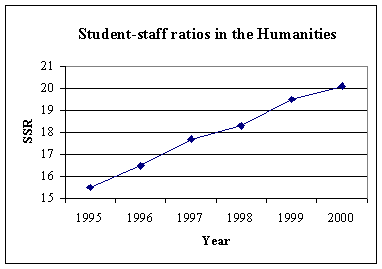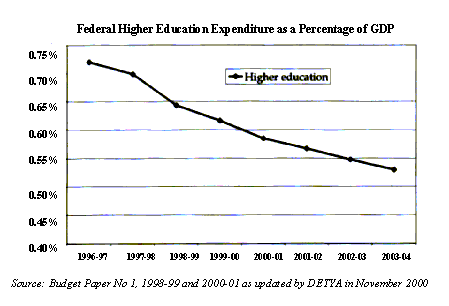Professor Sue Serjeantson is Executive Secretary of the Australian Academy of Science and for four years was Director of the Australian National University's Institute of Advanced Studies. A bit over a year ago, December 8th, as the President of the Federation of Australian Scientific and Technological Societies she pointed out, "The Australian Bureau of Statistics estimates that at the rate we are going in buying technology off the shelf overseas, our Budget deficit in information technology and telecommunications alone will be $28.8 billion in 2010-11... We need to be a whole lot more than a smart buyer of technology. We have to invest in our ideas and export our innovative products."
The Government's answer for "doing a whole lot more" has been to provide an additional $2.9 billion in Backing Australia's Ability over five years -- $159 million scheduled for 2001-02, increasing to $947 million for 2005-06. It also transpires that a particular rationalisation has accompanied the Coalition's parsimony, namely that Australia should aspire to be a close follower of the leading innovative nations. There appears to be no precise definition of what is meant by "being a close follower" but it certainly implies that striving for native excellence is not of high priority, and when it comes to garnering votes there are sufficient current indications that Mr. Howard's populist government has got it pretty right. On the other hand if it comes to the welfare of the nation he's got it terribly wrong. The insidiousness of the matter likens it to an infection with HIV rather than Ebola. Both are deadly but HIV may take years before it wreaks its appalling penalties, Ebola administers it coup de grâce in days. Ralph Waldo Emerson's admonition, "Do not go where the path may lead, go instead where there is no path and leave a trail," doesn't appear to be held in high regard in Canberra.
A couple of graphs and a small table to make the point:
Advertisement


According to the Group of Eight the additional five-year funds required to lift Australia's investment in R&D by 2005 to a level comparable with the 1998 OECD average of just over 2% of GDP needs to be $13.65 billion, by which time the OECD mean is expected to have risen a further 10% to 2.2% of GDP.
|
Source |
Additional Investment
($billions) |
| Business |
4.20 |
| Commonwealth |
6.75 |
| Non-Commonwealth |
2.70 |
|
TOTAL |
13.65 |
But if the murmurings coming from Canberra are more than mere speculation we are missing the point. We don't need to be up with the likes of the 1998 OECD AVERAGE nation, we need only to follow close behind. But how close is close? Even the Group of Eight's figures hardly indicate an aggressive scenario for moving Australia to the forefront of research and development. Following the Gof8 schedule we would achieve %GDP par with an OECD average nation during 2008-09 if the players in the table above all pull their weight and continued the additional funding.
Yet that proposal is well over the top so far as the Federal Coalition is concerned. It's as though that $2.9 billion to "Back Australia's Ability" is primarily to enhance our scavenging skills; i.e. its 43% of the $6.75 billion proposed by the Gof8. In fact the Government's proposal will at best, according to the Group of Eight's estimate, maintain Australia's R&D investment at the current percentage of GDP while the rest of the developed nations move on with deliberate speed; in short the dining table will be moved further and further out of reach making it all the more difficult to make a diving catch for the falling crumbs.
Advertisement
Leaving the metaphors aside, why is the vague concept of being a close follower arrant nonsense?
If Australia's tertiary educational system is poor, i.e. has outmoded facilities, few outstanding members of staff, and is chronically under funded, it will attract no better than mediocrity as either new staff or foreign students. The harsh truth is that, " 'ems as has, gits". So for example Harvard, Stanford, MIT, the University of California, Berkeley can attract among the best.
With very rare exceptions, top flight researchers have had outstanding mentors. Outstanding mentors rarely stay at mediocre institutions. According to Alan Gilbert, Vice-Chancellor of Melbourne University, Australia's best universities wouldn't make it into the top 100. If our best tennis player weren't in the top 100... too horrible to contemplate.
Discuss in our Forums
See what other readers are saying about this article!
Click here to read & post comments.